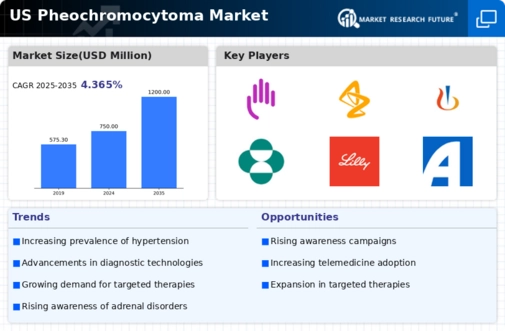Advancements in Treatment Modalities
Innovations in treatment modalities for pheochromocytoma are significantly influencing the pheochromocytoma market. Recent developments in surgical techniques, such as laparoscopic adrenalectomy, have improved patient recovery times and outcomes. Additionally, the introduction of targeted therapies and novel pharmacological agents is expanding the treatment landscape. For instance, the use of alpha-adrenergic blockers and beta-blockers has become more prevalent in managing symptoms. The market is projected to witness a compound annual growth rate (CAGR) of around 5% over the next few years, driven by these advancements. As healthcare providers adopt these new treatment options, the overall efficacy in managing pheochromocytoma is likely to improve, further stimulating market growth. This dynamic environment presents opportunities for pharmaceutical companies to innovate and capture market share.
Technological Integration in Healthcare
The integration of advanced technologies in healthcare is transforming the pheochromocytoma market. Innovations such as telemedicine, artificial intelligence, and electronic health records are enhancing patient management and treatment delivery. Telemedicine, in particular, allows for remote consultations, making it easier for patients to access specialists. This is especially beneficial for those in rural areas where access to healthcare may be limited. The adoption of AI in diagnostic processes is also improving accuracy and efficiency, potentially leading to earlier detection of pheochromocytoma. As these technologies become more prevalent, they are likely to drive market growth by improving patient engagement and treatment adherence. The overall impact of technological advancements is expected to foster a more efficient healthcare system, thereby benefiting the pheochromocytoma market.
Increasing Incidence of Pheochromocytoma
The rising incidence of pheochromocytoma in the US is a notable driver for the pheochromocytoma market. Recent estimates suggest that the annual incidence rate is approximately 2 to 8 cases per million people. This increase in diagnosed cases is likely attributed to improved awareness and advancements in diagnostic techniques. As more healthcare professionals recognize the symptoms associated with this rare tumor, the demand for effective treatment options is expected to grow. Consequently, pharmaceutical companies are focusing on developing targeted therapies, which could potentially enhance patient outcomes. The growing patient population necessitates a robust market response, thereby driving investments in research and development within the pheochromocytoma market. This trend indicates a promising future for stakeholders involved in the treatment and management of this condition.
Growing Awareness and Education Initiatives
The increasing awareness and education initiatives surrounding pheochromocytoma are pivotal in shaping the pheochromocytoma market. Organizations and healthcare providers are actively working to educate both the public and medical professionals about the signs and symptoms of this rare tumor. Enhanced awareness leads to earlier diagnosis and treatment, which is crucial for improving patient outcomes. Furthermore, educational campaigns are likely to increase the number of patients seeking medical attention, thereby expanding the market. The emphasis on awareness is expected to contribute to a projected market growth of approximately 4% annually. As more individuals become informed about pheochromocytoma, the demand for diagnostic and therapeutic options will likely rise, creating a more robust market environment.
Regulatory Support and Funding Opportunities
Regulatory support and funding opportunities are crucial drivers for the pheochromocytoma market. Government initiatives aimed at promoting research and development in rare diseases are becoming increasingly prominent. Grants and funding from federal agencies, such as the National Institutes of Health (NIH), are facilitating studies focused on pheochromocytoma. This financial backing encourages pharmaceutical companies to invest in the development of new therapies and diagnostic tools. Additionally, regulatory agencies are streamlining the approval processes for innovative treatments, which could expedite market entry. The combination of financial support and favorable regulatory environments is likely to enhance the growth prospects of the pheochromocytoma market. As more resources are allocated to this area, the potential for breakthroughs in treatment and management increases.

















Leave a Comment